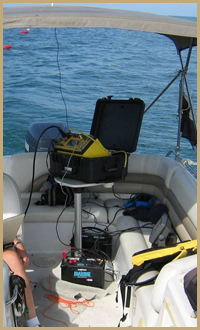 |
|
NSN utilizes CRP for rapid large-scale assessment of geology in shallow waters. Recent advances in this resistivity technology make it an accurate and cost-effective method of examining submerged geologic environments. The system incorporates a set of 11 electrodes which are towed by boat through the water along a grid. The Super Sting unit that controls the CRP system used by NSN was developed by Advanced Geosciences, Inc. (www.agiusa.com). The CRP arcs an electric current from two current electrodes and records the potential in the trailing nine electrodes. The underlying geology is mapped in real time, typically moving along the sea floor at a rate of 2 miles per hour. OET utilizes CRP cables designed to record to depths of 12 feet, 30 feet, 60 feet, and 100 feet (includes water column). A sonar unit and GPS are connected to the CRP unit to maintain an accurate position file and incorporate bathymetry into the processed data set. The data are compiled to produce a cross-section of resistivity values of geologic strata in the subsurface. This allows for the vertical differentiation of sand, clay, gravel, and rock units. CRP is also effective in identifying buried karst features such as caverns and changes in the porosity of surficial sediments. Some applications in which NSN has utilized CRP technology include: |

